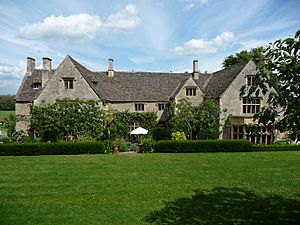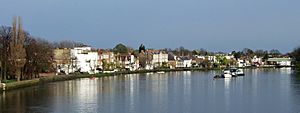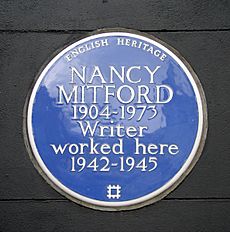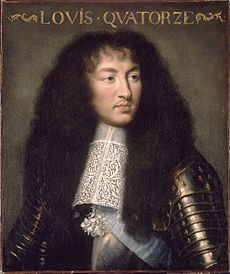Nancy Mitford facts for kids
Quick facts for kids
Nancy Mitford
|
|
|---|---|
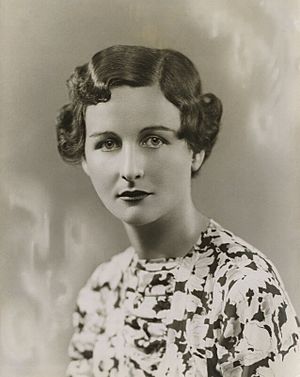 |
|
| Born | Nancy Freeman-Mitford 28 November 1904 London, England |
| Died | 30 June 1973 (aged 68) Versailles, France |
| Occupation | Novelist, biographer |
| Notable works | The Pursuit of Love Love in a Cold Climate Noblesse Oblige (ed.) |
| Spouse |
Peter Rodd
(m. 1933; div. 1957) |
| Parents | David Freeman-Mitford, 2nd Baron Redesdale (father) Sydney Bowles (mother) |
| Relatives | Mitford family |
Nancy Freeman-Mitford (born November 28, 1904 – died June 30, 1973), known as Nancy Mitford, was a famous English writer. She wrote novels and biographies. Nancy was the oldest of the six Mitford sisters. She was known for her clever and sometimes funny writing style. Her books often talked about the lives of upper-class people in England and France. She also wrote popular history books about famous people.
Nancy grew up in a wealthy family. She was the daughter of David Freeman-Mitford, who later became the 2nd Baron Redesdale. She learned at home and did not have formal writing training. Her first novel came out in 1931. It did not become very popular. But her later books, The Pursuit of Love (1945) and Love in a Cold Climate (1949), made her a well-known author. These books were partly based on her own life.
Nancy married Peter Rodd in 1933. Their marriage was not happy, and they divorced in 1957. After World War II, Nancy moved to France. She lived there until she passed away. She stayed in touch with her friends in England through many letters and visits.
In the 1950s, Nancy helped create the idea of "U" (upper-class) and "non-U" language. This idea suggested that the words people used could show their social background. Nancy meant it as a joke, but many people took it seriously. She became seen as an expert on manners and social rules.
Her later years brought both success and sadness. Her history books about Madame de Pompadour, Voltaire, and King Louis XIV were very popular. But her close friendship with Gaston Palewski did not turn out as she hoped. From the late 1960s, her health got worse. She suffered from a painful illness for several years before she died in 1973.
Contents
Who Was Nancy Mitford's Family?
The Mitford family has a long history, going back to the Norman era. A very old ancestor, Sir John de Mitford, owned Mitford Castle in Northumberland. The family kept a tradition of public service for many years. In the 18th century, William Mitford wrote an important history of ancient Greece.
His great-grandson, Algernon Bertram Mitford, was born in 1837. He was known as "Bertie." Bertie was a diplomat and traveler. He worked for the government from 1874 to 1880. In 1874, he married Clementina. This marriage connected the Mitfords to some of Britain's most important noble families. Clementina's sister, Blanche, married Henry Hozier. Their daughters included Clementine, who married Winston Churchill. He later became the British Prime Minister.
Bertie Mitford and Clementina had five sons and four daughters. Bertie left government work in 1886 when he inherited a lot of money. He rebuilt Batsford House in Gloucestershire, which was the family's large country home. He also served as a Member of Parliament for a short time. In 1902, he was given the title of 1st Baron Redesdale.
Important Mitford Family Members

Nancy Mitford's Childhood Years
Her Parents and Early Life
Nancy Mitford's father was David Bertram Ogilvy Freeman-Mitford. He was Bertie Mitford's second son, born in 1878. David worked as a tea planter in Ceylon for a few years. He then fought in the Second Anglo-Boer War and was badly hurt.
In 1903, David got engaged to Sydney Bowles. She was the daughter of Thomas Gibson Bowles, a journalist and magazine owner. They married in 1904 and lived in London. Sydney's father gave David a job at The Lady magazine. But David did not like reading or business, so the job was not a good fit. He stayed there for 10 years.
Nancy, their first child, was born on November 28, 1904. They first thought of naming her Ruby, but changed their minds to Nancy.
Growing Up and Schooling
Nancy's nanny and nursemaid mostly raised her. Her mother, Sydney, first believed children should never be corrected. This made Nancy very self-centered and hard to control. She would often have big tantrums.
Just before Nancy's third birthday, her sister Pamela was born. Nancy was upset that the nanny seemed to like the new baby more. She often teased and bothered Pamela as they grew up.
In 1909, her brother Tom was born, followed by another sister, Diana, in 1910. That summer, Nancy went to the Francis Holland School for a few months. This was almost all of her formal schooling. After that, she was taught at home by teachers called governesses.
The family spent summers at their cottage in Buckinghamshire. Winters were often spent with her grandparents at Batsford Park. In 1914, their fifth child, Unity, was born in London.
Life During Wartime
When World War I started in August 1914, Nancy's father, David, went to fight in France. In 1915, his older brother was killed. This meant David would inherit the Redesdale title and lands. On August 17, 1916, Bertie Mitford died. David became the 2nd Baron Redesdale while still fighting in the war.
Sydney quickly moved the family to Batsford House. Nancy loved reading in the large library there. This is where she started her love for books and learning.
After the war, Lord Redesdale decided to sell Batsford Park. It was too expensive to keep. The family moved to Asthall Manor in Oxfordshire in 1919. This old house became the setting for many family scenes in Nancy's later novels.
Nancy found growing up difficult. She often teased her younger brothers and sisters. The other children, led by Tom, even formed a "League against Nancy." But her teasing was also a way for her to handle her competitive sisters. She also created a magazine called The Boiler for their fun. It had funny, gruesome murder stories.
In 1921, Nancy finally got to go to a boarding school for a year. It was called Hatherop Castle. She learned French and other subjects there. She also joined the Girl Guides. This was her first time living away from home, and she enjoyed it. The next year, she went on a trip to Paris, Florence, and Venice. She wrote home about how much she loved the art and sights.
Becoming a Socialite and Writer
Nancy's eighteenth birthday in November 1922 was a big "coming-out" party. This marked her entry into London Society. In June 1923, she was formally presented to King George V at Buckingham Palace. After this, she could attend all the fancy balls and parties of the London social season. She spent the next few years going to many social events. She made new friends among the "Bright Young People" of the 1920s. Nancy said they "hardly saw the light of day, except at dawn."
In 1926, Asthall Manor was sold. The family moved to Paris for three months while their new house was prepared. This trip started Nancy's "lifelong love affair" with France.
Nancy became friends with Evelyn Gardner, who was engaged to the writer Evelyn Waugh. Nancy and Waugh became lasting friends. Nancy's father did not like most of her male friends. One of them was Hamish St Clair Erskine. He was an Oxford student four years younger than Nancy. They became unofficially engaged in 1928. Their engagement lasted for several years, despite her family and friends not approving.
To earn money, Nancy started writing. Evelyn Waugh encouraged her. She first wrote anonymous gossip columns for magazines. Then she wrote signed articles. In 1930, The Lady magazine hired her to write a regular column. That winter, she started her first full novel, Highland Fling. It was about a chaotic house party in Scotland. The book did not make much impact when it came out in 1931. She immediately started another novel, Christmas Pudding. This book also focused on the clash between young people and older generations. Her sister Diana and Unity were upset by how they were shown in the book.
Nancy's engagement to Hamish Erskine ended in June 1933. He told her he was going to marry someone else. Nancy was very sad.
Marriage, Books, and Politics
A month after her engagement ended, Nancy announced she was engaged to Peter Rodd. He was the son of a diplomat and politician. They married on December 4, 1933, and lived in a cottage in London. Nancy was happy at first, but soon worried about money. Her marriage was also difficult.
In 1934, Nancy started her third novel, Wigs on the Green. It was a satire about Sir Oswald Mosley's fascist "Blackshirt" movement. Nancy had briefly supported Mosley's party in 1931, but she quickly became against fascism. When the novel was published in 1935, it did not get much attention from critics. It also upset her family, especially her sisters Diana and Unity. They both supported Mosley and Adolf Hitler. Diana later forgave Nancy, but Unity was very angry about how she was shown in the book. Their relationship never fully healed.
By 1936, Nancy Mitford's marriage was not going well. In 1937, her younger sister Jessica ran away with her cousin Esmond Romilly. He was a rebellious former schoolboy and a supporter of communism. He fought in the Spanish Civil War. Nancy went to bring them home but could not persuade them. Jessica and Esmond married in May 1937.
In 1938, Nancy was editing letters for a book. This took up a lot of her time and made her relationship with Peter Rodd worse. She became pregnant that summer but lost the baby in September. In 1939, Rodd went to France to help Spanish refugees. Nancy joined him for several weeks. She was very affected by what she saw. This experience made her even more against fascism. She said she would do anything to stop it.
Nancy Mitford was a moderate socialist, meaning she believed in social equality. But some of her writings also defended the traditions of the upper class she grew up in.
World War II and New Beginnings
When World War II started in September 1939, the Mitford family was divided. Nancy and Peter Rodd supported the Allies. Her brother Tom went to America. Her sisters Diana and Unity supported Germany. Diana and her husband, Sir Oswald Mosley, were even put in jail. Nancy told British intelligence that Diana was a "devoted fascist and admirer of Hitler."
During the war, Nancy worked as an Air Raid Precautions (ARP) driver. She also worked at a first-aid post. She used these experiences in her fourth novel, Pigeon Pie. It was a comedy about spying. The book came out in May 1940 but did not sell well. People were not interested in lighthearted war stories.
In April 1940, Nancy had another health problem. Shortly after, Peter Rodd went overseas with the army. Nancy was alone in London during the London Blitz. She moved to her family's house, which was being used to help Jewish families who had lost their homes in bombings. Nancy spent a lot of time helping these families.
In 1941, Nancy had a serious operation. After she recovered, she started working at the Heywood Hill bookshop in London. The shop became a popular meeting place for writers. In September 1942, she met Gaston Palewski. He was a French officer working with General Charles de Gaulle. Nancy found him very interesting. He became a close friend and inspired much of her future writing.
The failure of Pigeon Pie had made Nancy not want to write. But in 1944, Evelyn Waugh encouraged her to start a new novel. In March 1945, she took time off from the bookshop to write. The Pursuit of Love was a romantic comedy based on her own life. Many of her family and friends appeared in it. Despite the sad news that her brother Tom had died fighting in Burma, she finished the book.
In September, she went to Paris. She wanted to be close to Palewski, who was now part of the French government. She returned to London in December 1945 for the publication of The Pursuit of Love. The book was an instant and huge success. It sold 200,000 copies in a year. It made Nancy Mitford a best-selling author.
Living in Paris
After the war, Peter Rodd returned home. But Nancy's marriage was over. They remained friends but lived separate lives. Nancy loved France and moved to Paris in April 1946. She never lived in England again. She wrote many letters to her friends, keeping in touch with everyone.
Her Home in Rue Monsieur
For the first 18 months in Paris, Nancy lived in different places. She had a busy social life, often at the British Embassy. She eventually found a comfortable apartment at No. 7 rue Monsieur. It was close to Palewski's home. She settled into a routine of social events, entertaining, and writing. She also made regular short visits to England and spent summers in Venice.
In 1948, Nancy finished a new novel, Love in a Cold Climate. It was a sequel to The Pursuit of Love. It was set in the same country house and had many of the same characters. The book was even more popular than the first.
In 1950, she translated a French play called La petite hutte into English. It was called The Little Hut and was very successful in London. It ran for a long time and earned Nancy a lot of money. That same year, The Sunday Times asked her to write a regular column, which she did for four years.
In 1951, she wrote her third postwar novel, The Blessing. This was another romance, set in Paris. It was about an Englishwoman married to a French nobleman. The writer Harold Acton called it her most complete novel. He said it showed her "joyous love of France."
Nancy then started her first serious non-fiction book, a biography of Madame de Pompadour. When it was published in 1954, critics thought it was "marvelous entertainment."
Noblesse Oblige and Social Language
In 1954, a professor named Alan Ross created the terms "U" and "Non-U." These terms were used to describe how different social classes in England spoke. "U" meant upper-class language, and "Non-U" meant language used by other groups. Ross used Nancy's novel The Pursuit of Love as an example of upper-class speech.
Nancy thought this was funny. She included the "U and Non-U" idea in an article she wrote for Encounter magazine. The article was about the English upper class. When it was published in September 1955, it caused a big stir. Many people did not realize it was a joke. Nancy received hundreds of letters from worried readers. They wanted to know if they were "snobs" or "common."
Because of all the interest, the article was published as a short book in 1956 called Noblesse Oblige. The book also included parts of Ross's original article and writings from other authors. It was a huge success. "U and Non-U" became a very popular phrase. Nancy's comments made her an expert on good manners for many years. It is interesting that these famous terms were not her own idea, but she used them to create a fun "tease."
Later Writing Career
In October 1957, Palewski became France's ambassador to Italy. Nancy saw him less often. She mostly hid her feelings about this separation. In March 1958, Nancy's father, Lord Redesdale, died.
Meanwhile, Nancy finished her next book, Voltaire in Love. It was about the love story between Voltaire and the Marquise du Châtelet. She thought it was her best and most mature work. It was published in 1957 and sold well. Critics and friends praised it.
Nancy then returned to writing fiction. She wrote Don't Tell Alfred, bringing back Fanny Wincham, the narrator from her earlier novels. The book was popular with readers but received mixed reviews. Some of Nancy's friends did not like it, and she decided not to write any more fiction.
In August 1962, Palewski returned to Paris as a government minister. But this did not mean he and Nancy saw each other more often. Their friendship continued from a distance. In April 1963, Nancy was in England for her cousin's wedding. A month later, she returned for her mother's funeral. Many of Nancy's friends were also passing away. Evelyn Waugh, a close friend, died in 1966. Nancy said that everything with Evelyn was a joke. Their friendship was one of the most important literary friendships of the 20th century.
Nancy continued to write despite these personal events. In 1964, she started working on The Sun King, a biography of King Louis XIV. Her publishers decided to make it a beautiful "coffee table" book with many pictures. When it was published in August 1966, President de Gaulle even recommended it to his government. By this time, Nancy's friendship with Palewski had become less active. She knew their best days would not return. She decided to leave Paris and buy a house in Versailles.
Final Years and Legacy
Nancy moved to Versailles in January 1967. Her new house had a garden, which she loved. In 1968, she started her last book, a biography of Frederick the Great. In March 1969, she learned that Palewski had married someone else. Nancy had accepted that he would never marry her, but the news still hurt her.
Soon after, she had surgery to remove a tumor. She continued to feel pain but kept working on her book. Frederick the Great was published in 1970. Nancy's remaining years were filled with illness. But she still enjoyed visits from her sisters and friends, and working in her garden.
In 1972, the French government made her a Chevalier of the Légion d'Honneur. Later that year, the British government made her a Commander of the Order of the British Empire (CBE). She was very happy about the French honor. She found the British one amusing, remembering that Evelyn Waugh had called it an "insult."
At the end of 1972, she went to a clinic in London. She was diagnosed with Hodgkin's lymphoma, a type of cancer. She lived for another six months, in constant pain and needing help. She tried to stay cheerful. She died on June 30, 1973, at her home in Versailles. Her ashes were buried in Swinbrook, next to her sister Unity.
Nancy Mitford's Writings
Nancy Mitford did not have formal training as a writer. Her style, especially in her early novels, was informal and chatty. It was much like her letters. She was known for her cleverness and sharp way of expressing herself.
Her Novels
Nancy's novels were about upper-class family life. They are known as "comedies of manners." Her main characters were often smart women surrounded by funny and unusual people. These characters were often based on herself and her family.
Critics usually say her novels written after the war are much better than her earlier ones. The Pursuit of Love is seen as a perfect novel. It and Love in a Cold Climate give a real picture of country house life in England between the wars. They are still studied by historians today.
In these later novels, you can hear Nancy Mitford's unique voice. It is light and bright, showing a view of life that is hard to shock and easy to bore. Sometimes, a more serious feeling appears. Beneath the light surface, there is a hint of sadness about love and its results.
The Blessing has had different reactions. Some critics loved it, saying Nancy's writing had grown up. Others felt she was less sure when writing about France than about English country life. Her last novel, Don't Tell Alfred, also received mixed reviews. Some wondered what parts were meant to be serious.
Her Biographies
Nancy used her skill for creating vivid characters in her four biographies. In her first, Madame de Pompadour, she aimed to write a popular history. She wanted it to be pretty and entertaining. This became her goal for all her history books.
She described Voltaire in Love as a report of his and others' love lives. The Sun King is considered a very entertaining introduction to the life of King Louis XIV. Critics noted her informal style. They said her ability to make difficult historical information readable was a skill any historian would envy.
Journalism and Letters
Nancy did not see herself as a journalist. But her articles were popular, especially those about Paris life for The Sunday Times. These articles brought France to English readers in a way they loved.
Her letters are also very important. They show her true character with their freedom of expression and playful ideas. Many of her letters have been published in collections. They are full of her sharp and entertaining wit.
List of Nancy Mitford's Books
Novels
- Highland Fling (1931)
- Christmas Pudding (1932)
- Wigs on the Green (1935)
- Pigeon Pie (1940)
- The Pursuit of Love (1945)
- Love in a Cold Climate (1949)
- The Blessing (1951)
- Don't Tell Alfred (1960)
Biographies
- Madame de Pompadour (1954)
- Voltaire in Love (1957)
- The Sun King: Louis XIV at Versailles (1966)
- Frederick the Great (1970)
Translation
- The Little Hut (1951) (a play translated from French)
As Editor
- The Ladies of Alderley: Letters 1841–1850 (1938)
- The Stanleys of Alderley: Letters 1851–1865 (1939)
- Noblesse Oblige: An Inquiry into the Identifiable Characteristics of the English Aristocracy (1956)
Collections of Letters
- Love from Nancy: The Letters of Nancy Mitford (1993)
- The Letters of Nancy Mitford and Evelyn Waugh (1996)
- The Mitfords: Letters Between Six Sisters (2007)
- The Bookshop at 10 Curzon Street: Letters between Nancy Mitford and Heywood Hill 1952–73 (2004)
Images for kids
See also
 In Spanish: Nancy Mitford para niños
In Spanish: Nancy Mitford para niños



